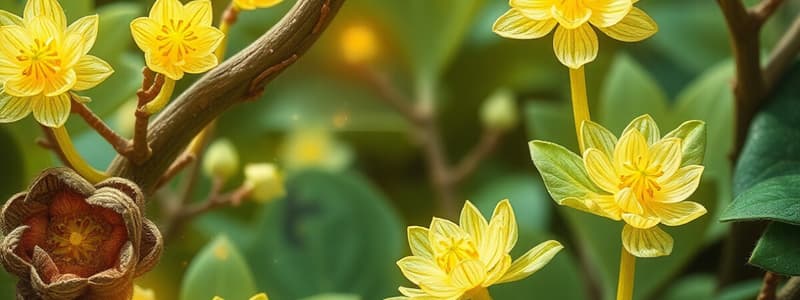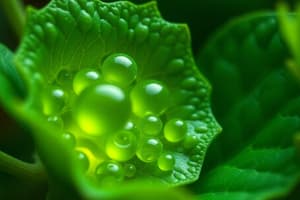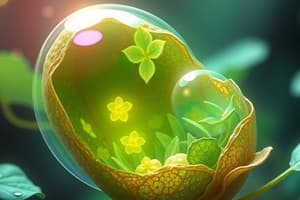Podcast
Questions and Answers
How does photosynthesis relate to cellular respiration?
How does photosynthesis relate to cellular respiration?
- Photosynthesis and cellular respiration are the same thing, both convert energy from sunlight into food.
- There is no relation between phtotosynthesis and cellular respiration.
- Photosynthesis is essentially the reverse of cellular respiration; one creates sugars and expels oxygen, while the other uses sugar and oxygen. (correct)
- Photosynthesis uses the oxygen that cellular respiration breathes out.
What is the role of chlorophyll in photosynthesis?
What is the role of chlorophyll in photosynthesis?
- Chlorophyll is the green pigment that absorbs particular wavelengths of visible light,contained in thylakoid membranes of chloroplasts that is used in photosynthesis by plants. (correct)
- Chlorophyll converts carbon dioxide into oxygen in the thylakoid membranes.
- Chlorophyll provides structure and support
- Chlorophyll helps the plant take in water.
Which of the following is the correct chemical equation for photosynthesis?
Which of the following is the correct chemical equation for photosynthesis?
- $6O_2 + C_6H_{12}O_6 \rightarrow 6CO_2 + 6H_2O$
- $6CO_2 + 6H_2O \rightarrow C_6H_{12}O_6 + 6O_2$ (correct)
- $C_6H_{12}O_6 + 6O_2 \rightarrow 6CO_2 + 6H_2O$
- $6CO_2 + C_6H_{12}O_6 \rightarrow 6H_2O + 6O_2$
In what part of the plant cell does photosynthesis take place?
In what part of the plant cell does photosynthesis take place?
Plants use carbon dioxide, water, and energy from the sun to produce their own food. What is the name of the food that it creates?
Plants use carbon dioxide, water, and energy from the sun to produce their own food. What is the name of the food that it creates?
Flashcards
Photosynthesis
Photosynthesis
The process where plants, some bacteria, and protists convert sunlight energy into food (sugars).
Photosynthesis Equation
Photosynthesis Equation
6CO2 + 6H2O -> C6H12O6 + 6O2; Carbon dioxide and water become glucose and oxygen.
Chloroplasts
Chloroplasts
Organelles within plant cells where photosynthesis takes place; contain chlorophyll.
Pigment
Pigment
Signup and view all the flashcards
Chlorophyll
Chlorophyll
Signup and view all the flashcards
Study Notes
- Plants make their own food through photosynthesis, using sunlight and water, unlike other organisms that need to eat.
- Photosynthesis is carried out by plants, some bacteria, and protists.
- Photosynthesis converts energy from sunlight into food.
- Photosynthesis requires sunlight, carbon dioxide, and water.
- The chemical equation for photosynthesis is: 6CO2 + 6H2O -> C6H12O6 + 6O2.
- CO2 represents carbon dioxide.
- H2O represents water.
- C6H12O6 represents glucose.
- O2 represents oxygen.
- Photosynthesis is essentially the reverse of cellular respiration.
- Photosynthesis uses carbon dioxide, water, and sunlight to produce sugars and oxygen.
- Chloroplasts are organelles within plant cells where photosynthesis occurs.
- Chloroplasts are located in leaf cells.
- Chlorophyll is a green pigment found in thylakoid membranes of chloroplasts.
- Chlorophyll in bacteria is found in the plasma membrane.
- A pigment is a compound that absorbs specific wavelengths of visible light.
- The electromagnetic spectrum includes wavelengths from radio waves to gamma rays.
- Chlorophyll and other pigments absorb specific visible wavelengths.
- Visible light has wavelengths ranging from 700 nm (red) to 400 nm (blue).
- Shorter wavelengths have higher energy, while longer wavelengths have lower energy.
- Chlorophyll absorbs mostly blue and red wavelengths.
- Chlorophyll reflects green wavelengths, which is why plants appear green.
- The color of a pigment is the wavelength of light it reflects.
- Chlorophyll contains electrons at a ground state.
- When chlorophyll absorbs light energy, electrons jump to an excited state.
- Excited electrons are transferred from chlorophyll to a primary electron acceptor.
- Chlorophyll becomes oxidized during this process.
- Accessory pigments absorb other wavelengths of light and pass energy to chlorophyll.
- Accessory pigments expand the range of wavelengths that can be used for photosynthesis.
Studying That Suits You
Use AI to generate personalized quizzes and flashcards to suit your learning preferences.




